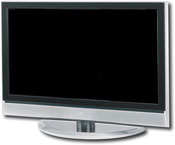-
-
-
-
-
-
-
-
-
-
-
-
-
-
-
-
+
-
-
-
-
-
-
-
-
-
-
-
-
+
-
+
-
-
-
-
-
-
-
-
-
-
-
-
-
-
-
Flat Screens
Flat screens are a common element in media installations, providing a potentially elegant and aesthetic alternative to projection while using a minimum of space. More often than not, flat screens do not come with internal speakers for audio playback. It is important to make sure that the screen can accept input from the playback device you are using. There are two distinct types of flat screens: plasma and LCD. These technologies use fixed-pixel arrays, which means they have rows and columns of individual picture elements that turn on and off to produce the necessary patterns of light.
With flat screens, one must consider aspect ratio, which refers to the relationship or ratio between the width and the height of the image. There are two standard aspect ratios: 4:3 and 16:9. A standard TV has an aspect ratio of 4:3, which means that the picture is four units wide for every three units of height. HDTV standard is 16:9, which is 16 units of width for every 9 units of height. These ratios are also expressed as 1.33:1 and 1.78:1. 16:9 better accommodates wide-screen formats, common in commercial film since the 1950s. Most commercial films produced during the last 50 years have ratios of either 1.85:1 or 2.35:1.

Plasma display devices have higher resolution than most conventional TV sets, and are capable of displaying full HDTV and DTV signals as well as XGA, SVGA, and VGA signals from a computer. Most plasma monitors can accept any video format. There are two types of plasma screen: EDTV (for ?enhanced definition television?) and HD. HD-compatible screens are capable of displaying full-resolution HD-standard video, most often from commercial DVD or television broadcast, and are compatible with less robust formats. Plasma screens have no scan lines because each and every pixel cell has its own transistor electrode. This creates a smooth, evenly lit image across the entire surface of the display. Most current displays also include built-in line doubling to improve image quality from low-resolution video signals. Plasma screens also provide uniform brightness, illuminating all pixels evenly across the screen, and offer a viewing angle of 160 degrees (top to bottom and left to right) - much better than rear-projection TVs and LCD displays. This allows a larger number of viewers to enjoy proper image reproduction from a wider variety of locations throughout the exhibition space. One drawback: Because plasma screens use phosphors to generate light, they can be subject to "burn-in" - that is, when a static image is left on the screen for a long time, it may not completely disappear when the image changes.

LCD screens typically range from 15-inch models designed primarily as computer monitors up to 37-inch wide-screen designs complete with speakers and TV tuners. LCDs have lower contrast ratios than plasma screens, primarily because they have a harder time reproducing deep black and dark grays. They also tend to be one to several inches thicker than plasma screens and have a narrower effective viewing angle. Among their advantages, LCDs are completely immune to burn-in, and they more often include all the standard features of a conventional TV. LCDs also run cooler than plasmas, minimizing the need for potentially noisy fan cooling.







